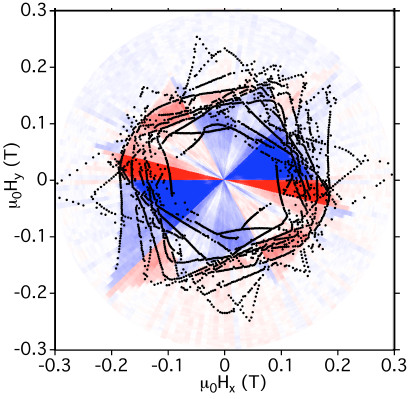Nanomagnetism
In order to avoid the complications due to distributions of particle size, shape, and so on, we studied the temperature and field dependence of magnetization reversal of individual magnetic nanoparticles, wires, and rings using the micro-SQUID technique. The angular dependence of the hysteresis loops established the magnetization reversal mode (uniform rotation, curling, or domain wall nucleation). Waiting time, switching field, and telegraph noise measurements showed that the magnetization reversal of a well prepared ferromagnetic nanoparticle can be described by thermal activation over a single-energy barrier as originally proposed by Néel and Brown. Below a crossover temperature, strong deviations from this model are evidenced which are quantitatively in agreement with the predictions of the theory of macroscopic quantum tunneling of magnetization in the low dissipation regime. For single 1000-atom cobalt nanoparticles, we showed that the magnetic anisotropy contributions are dominated by surface atoms. We proposed and demonstrated a new method to overcome high switcher fields. A constant applied field, well below the switching field, combined with a radio-frequency (RF) field pulse can reverse the magnetization of a nanoparticle.
 |
|
Fig.: Angular dependence of the switching field measured on an ensemble of Co
nanoparticles. |
References:
Wernsdorfer, W.; Doudin, B.; Mailly, D.; Hasselbach, K.; Benoit, A.; Meier, J.; Ansermet, J. P. & Barbara, B.
Nucleation of magnetization reversal in individual nanosized nickel wires
Physical Review Letters, 1996, 77, 1873-1876
Wernsdorfer, W.; Orozco, E. B.; Hasselbach, K.; Benoit, A.; Barbara, B.; Demoncy, N.; Loiseau, A.; Pascard, H. & Mailly, D.
Experimental evidence of the Neel-Brown model of magnetization reversal
Physical Review Letters, 1997, 78, 1791-1794
Wernsdorfer, W.; Orozco, E. B.; Hasselbach, K.; Benoit, A.; Mailly, D.; Kubo, O.; Nakano, H. & Barbara, B.
Macroscopic quantum tunneling of magnetization of single ferrimagnetic nanoparticles of barium ferrite
Physical Review Letters, 1997, 79, 4014-4017

